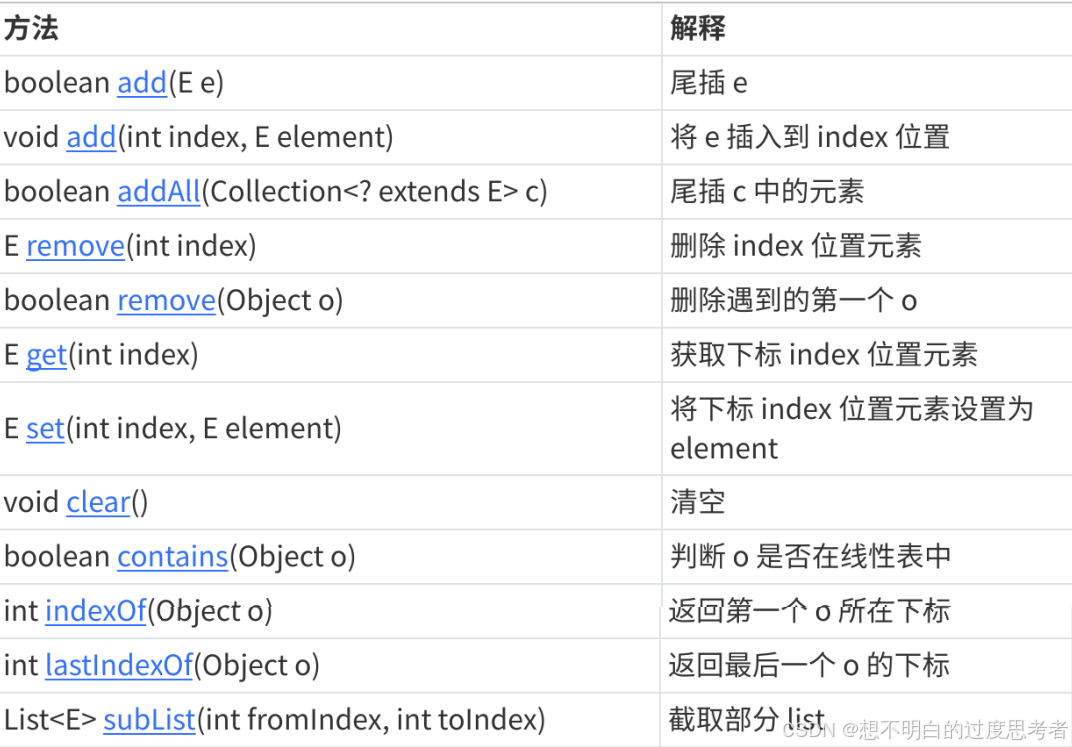📌 深入理解LinkedList与链表:从原理到实战应用
🌟 引言
在Java集合框架中,LinkedList和ArrayList是最常用的两种列表结构。它们各有优劣,适用于不同的场景。本文将带你深入探索LinkedList的底层实现------链表,并通过丰富的代码示例和对比分析,帮助你全面掌握其特性和应用场景。

📚 1. ArrayList的缺陷
ArrayList底层基于动态数组 实现,虽然支持高效的随机访问(时间复杂度为O(1)),但在任意位置插入或删除元素时,需要搬移后续元素,导致时间复杂度为O(n)。例如:
java
ArrayList<Integer> list = new ArrayList<>();
list.add(1); // 添加到末尾,O(1)
list.add(0, 0); // 插入到头部,O(n)缺陷总结:
- 插入/删除效率低(尤其是头部或中间位置)。
- 扩容时需要拷贝数据,额外开销大。
🔗 2. 链表:LinkedList的底层结构
2.1 链表的概念
链表是一种物理存储非连续 的数据结构,通过节点的引用(指针)实现逻辑上的连续性。

特点:
- 节点包含数据域和指针域。
- 物理上不连续,逻辑上连续。
2.2 链表的分类
链表有多种结构组合,常见的两种:
-
无头单向非循环链表 :结构简单,常用于面试题。
-
无头双向循环链表 :Java中
LinkedList的底层实现。
双向链表节点定义:
java
class Node {
int val;
Node prev;
Node next;
}⚙️ 3. LinkedList的模拟实现
以下是一个简化版的无头单链表实现:
java
/*关于LinkedList的实现练习,只实现String属性*/
//通过这个类来表示一个链表的单链表节点,如果是双链表还需要一个prev
class Node{
//节点保存的值,为了练习方便把属性设置为public
public String value;
//节点的下一个元素
public Node next;
//创建构造方法进行初始化
public Node(String value){
this.value = value;
this.next = null;
}
}
public class MyLinkedList {
//表示链表的头节点
//由于此处不考虑傀儡节点,所以当head为空时,表示为一个空链表
private Node head = null;
//不像顺序表搞一个size表示有效元素的区间
//尾插
public void addLast(String value){
//如果head为null,直接让它指向新节点
if(head == null){
Node newNode = new Node(value);
head = newNode;
return;
}
//思路:先找到尾巴
//先把尾巴指向head节点,一直遍历往下找
Node tail = head;
for (; tail != null; tail = tail.next){
if(tail.next == null){
break;
}
}
//通过上述循环,循环结束之后,此时的tail指向尾巴了
//此时就创建新的节点,让尾节点的next指向newNode
Node newNode = new Node(value);
tail.next = newNode;
//再把newNode的节点指向null,由于在构造方法中中已经做了这件事,不写也没关系
newNode.next = null;
}
//头插
public void addFirst(String value){
//根据刚才value的值,创建一个节点
Node newNode = new Node(value);
//把新的节点放到头位置做两件事:
//1.把新节点的next指向原来的头节点
newNode.next = head;
//2.让head指向新节点
head = newNode;
}
//指定位置插入
public void add(int index, String value){
}
//重写toString通过这个方法去遍历链表,构成一个字符串,方便打印
@Override
public String toString() {
//遍历的时候,需要从头结点开始,进行一个元素一个元素的打印
StringBuilder str = new StringBuilder();
str.append("[");
for (Node current = head;current != null;current = current.next){
if(current.next != null){
str.append(current.value);
str.append(",");
}else {
str.append(current.value);
}
}
str.append("]");
return str.toString();
}
//----------------------------------------------------------
public static void test1(MyLinkedList list){
list.addFirst("A");
list.addFirst("B");
list.addFirst("C");
System.out.println(list);
}
public static void test2(MyLinkedList list){
list.addLast("A");
list.addLast("B");
list.addLast("C");
list.addLast("D");
list.addLast("E");
System.out.println(list);
}
public static void main(String[] args) {
MyLinkedList list = new MyLinkedList();
test1(list);
MyLinkedList list2 = new MyLinkedList();
test2(list2);
}
}以下是一个简化版的双向链表实现:
java
public class MyLinkedList {
private Node head;
private Node tail;
private int size;
// 头插法
public void addFirst(int data) {
Node newNode = new Node(data);
if (head == null) {
head = tail = newNode;
} else {
newNode.next = head;
head.prev = newNode;
head = newNode;
}
size++;
}
// 删除指定值的节点
public void remove(int key) {
Node cur = head;
while (cur != null) {
if (cur.val == key) {
if (cur == head) {
head = head.next;
if (head != null) head.prev = null;
} else {
cur.prev.next = cur.next;
if (cur.next != null) cur.next.prev = cur.prev;
}
size--;
return;
}
cur = cur.next;
}
}
}🛠️ 4. LinkedList的使用
4.1 Java集合框架部分:LinkedList继承体系(思维导图)
Iterable Collection List Queue LinkedList Deque AbstractSequentialList AbstractList Serializable Cloneable
4.2 常用方法

4.3 遍历方式
java
// 1. for-each循环
for (int num : list) {
System.out.print(num + " ");
}
// 2. 迭代器
Iterator<Integer> it = list.iterator();
while (it.hasNext()) {
System.out.print(it.next() + " ");
}
// 3. 反向迭代器
Iterator<Integer> rit = list.descendingIterator();
while (rit.hasNext()) {
System.out.print(rit.next() + " ");
}🧩 5. 经典链表OJ题解析
5.1 反转链表
题目 :反转一个单链表。
代码:
java
public ListNode reverseList(ListNode head) {
ListNode prev = null;
ListNode cur = head;
while (cur != null) {
ListNode next = cur.next;
cur.next = prev;
prev = cur;
cur = next;
}
return prev;
}5.2 判断链表是否有环
快慢指针法:
java
public boolean hasCycle(ListNode head) {
ListNode slow = head, fast = head;
while (fast != null && fast.next != null) {
slow = slow.next;
fast = fast.next.next;
if (slow == fast) return true;
}
return false;
}📊 6. ArrayList vs LinkedList
| 对比维度 | ArrayList | LinkedList |
|---|---|---|
| 底层结构 | 动态数组 | 双向链表 |
| 随机访问 | O(1) | O(n) |
| 头插/删效率 | O(n) | O(1) |
| 内存占用 | 连续空间,可能浪费 | 分散存储,无浪费 |
| 适用场景 | 频繁访问+少量修改 | 频繁插入/删除 |
选择建议:
- 需要快速随机访问?选
ArrayList! - 频繁在头部或中间插入/删除?选
LinkedList!
💡 7.记忆技巧
bash
Iterable是根源,
Collection分三派(List/Queue/Set),
List有三各不同:
数组实现ArrayList,
链表实现LinkedList,
线程安全Vector顶。
标记接口要记清:
Serializable可序列,
Cloneable能复制,
RandomAccess随机快。🎯 总结
- 链表通过节点引用实现逻辑连续,适合频繁修改的场景。
- LinkedList在Java中基于双向链表实现,提供了高效的插入/删除操作。
- 理解链表的核心在于掌握指针操作和边界条件处理。
通过本文的学习,相信你对链表和LinkedList有了更深入的理解!快去LeetCode上挑战更多链表题目吧!
💬 互动话题 :你在项目中用过LinkedList吗?遇到过哪些坑?欢迎评论区分享!
